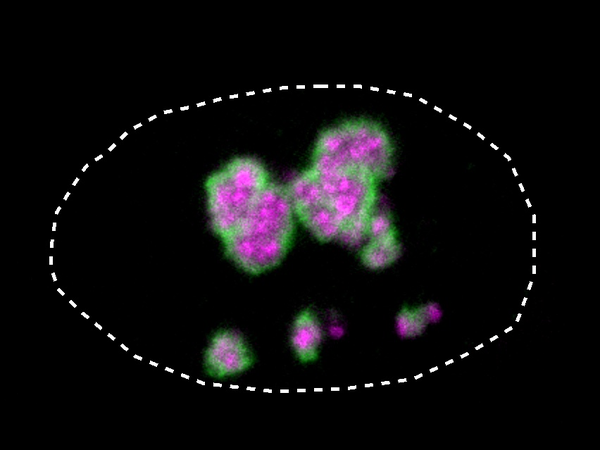Whether it is diabetes, an attack of rheumatism or a tumor in the breast – for as long as there have been people, they have become ill and ask themselves: Why? The punishment of any god? Because the “humors of the body are not in balance”, as the Greco-Roman physician Galen suspected almost 2000 years ago, and after him almost all physicians of the Middle Ages?
Today we take it for granted that rheumatism is caused by misdirected immune cells attacking our own body, diabetes by a lack of insulin, tuberculosis by bacteria, influenza by viruses and cancer by gene mutations. And we are aware that this knowledge is crucial in developing therapies or providing relief.
Nevertheless, there are still thousands of diseases whose causes doctors and researchers can only puzzle over. A German research team has now made a discovery that could provide patients with a wide variety of diseases with clarity – and possibly also help. While searching for the error that triggers an extremely rare hereditary disease, the scientists discovered something that could also explain the mechanism by which more common diseases such as cancer develop. A completely new disease principle. It has to do with vinegar, oil and the mail.
Rare syndrome – common principle
The story begins with babies who are born with severe malformations of the bones and nerves in their arms, legs, face and other parts of their bodies. It is extremely rare for physicians to see this syndrome, brachyphalangy polydactyly and tibial aplasia/hypoplasia, or BPTA for short. Less than ten cases have been documented worldwide. And although it hardly seemed worthwhile to search for the cause of such a rare disease in a time-consuming and expensive manner, since no therapy in the world can reverse such malformations, it now turns out that the fundamental findings of this research will eventually benefit tens of thousands, maybe millions of sick people could help.
If this works, it could also work against cancer.
Denes Hnisz, Max Planck Institute for Molecular Genetics (MPIMG) in Berlin-Dahlem
The research team led by Denes Hnisz from the Max Planck Institute for Molecular Genetics in Berlin analyzed the genetic information of five of these children with BPTA. It turned out that only a minimal change in a single gene is responsible for the severe malformations: HMGB1. It carries the blueprint for a protein that is normally distributed evenly in the nucleus of every cell and is involved in storing the wafer-thin strands of genetic material properly or making them readable. But not with the affected five children.
A mutation in them changes the chemical properties of the HMGB1 protein in such a way that it can suddenly be found in the wrong place in the cell nucleus: in the nucleus, the nucleolus – a very special place, a tiny droplet of about 0.2 microns in the cell nucleus. The components of the cell’s protein factories, the ribosomes, are built in this moist blob. Just as the machines for countless factories around the world are produced in Germany, the ribosome machines are created in the nucleolus, which then assemble the proteins from amino acids in the universe of the cell.

However, the HMGB1 protein has no place in the nucleolus. The mutation looks like someone changed the address on a letter. The protein ends up at the wrong recipient. “The mutation that causes BPTA syndrome results in two changes,” says Hnisz. “One is that the address is changed, misdirecting the HMGB1 protein into the nucleolus, the other part is altered in such a way that a helix forms – and that is toxic to the nucleolus.”
It causes the actually liquid nucleolus drop to solidify. As a result, no more ribosomes can be produced, the supply of proteins stops, and the cell dies.
So far that would not be a sensation. Just elucidating the cause of a very rare hereditary disease.
Involved in 101 diseases
The surprise only came when Hnisz and colleagues searched the gene databases for mutations that gave proteins similar wrong address labels, i.e. proteins could misdirect in a similar way to HMGB1 in BPTA patients. “We have discovered more than 600 such changes in 66 proteins, 101 of which are known to be associated with diseases.” And completely different diseases: including cancer, neurodevelopmental disorders and microcephaly, i.e. a reduced head.
“It seems as if all these diseases, which appear completely different, have a single, always the same molecular cause,” says Hnisz: a harmful change in the nucleolus that poisons the cell. To check this, the research team tested 13 of these 66 mutated proteins in cell cultures: In fact, 12 of them got into the nucleolus as a result of the mutation and half disrupted the function of the nucleus.

“The development mechanism that we discovered in the BPTA syndrome could therefore come into play in many other diseases,” says Denise Horn, from the Institute for Medical Genetics and Human Genetics at the Charité, who led the research team with Hnisz and Malte Spielmann from the Kiel University Hospital UKSH headed. “We are thus opening a door that could lead to the clarification of numerous other diseases.”

Because in cells there are many other “droplets” such as the nucleolus. They are collections of proteins and other biomolecules, such as RNA, that come together to perform specific cellular functions. Biologists have only known about these droplets, so-called condensates, for a few years. They form similar to how vinegar droplets settle in oil, through the separation of two liquid phases due to their chemical-physical properties. “Nucleoli are the best-studied condensates,” says Hnisz. The condensate concept is the long-sought-after explanation of how all the different proteins that are required, for example, to read a gene or to break down waste in the cell, which is huge by molecular standards, come together to fulfill their tasks. They all have “addresses” that direct them either to membrane-encased, permanent cell structures (organelles) or to rather short-lived condensates that can be dissolved and re-formed at any time.
So far, however, it has been a mystery how these addresses are created. Researchers have identified specific appendages of proteins, “intrinsically disorganized regions,” IDRs, as signposts. But Hnisz is convinced there are many more. “It is difficult to find these addresses in the protein sequences,” says the researcher. Because the addresses don’t work like a label that sticks on a box and tells the postman the destination, rather it is the shape of the package or that it has a positive charge on one side and a negative charge on the back that make up the Boy Scout code put together. “The target information is scattered throughout the protein, it’s a structural thing,” says Hnisz.
Knowing about condensates and misdirected proteins will no longer help children affected by BPTA. “Unfortunately, that’s the case with developmental diseases,” says Hnisz. “By the time we see the patients, the damage has usually already been done.” But one can use the knowledge to introduce beneficial small molecules into the nucleolus or other condensates to restore normal function. Or one finds ways to keep the harmful, mutated proteins away from the nucleolus or other condensates. “If we diagnose the cause early, there is a greater chance of being able to stop the disease before major damage is done.”
The poison becomes the therapy
Even if the knowledge does not help these patients, it may help others, with completely different diseases, but which can be traced back to the same principle, defective condensate droplets. In fact, Hnisz is already working on a therapy based on the findings of BPTA research: “If this works, it could also work against cancer.”
The idea, which is “a bit crazy,” is based on this short helix’s property of being toxic to condensates, says the researcher. If you introduce the helix into condensates that are typical of cancer cells, so-called oncoprotein condensates, you could poison them, kill the tumor cells and cure the cancer.
Whether this can work, however, is completely open. So far, the Hnisz team has only tested the effect of the helix in cell cultures. Experiments in mice or humans are not yet to be thought of. The native Hungarian is already confident enough to co-found a biotech company. Barcelona-based Nuage Therapeutics is looking for small molecules that can be used to manipulate proteins in or on the way to condensates. Dewpoint, founded in Boston and Dresden, is also looking for ways to treat condensates to fight disease.
It’s that kind of confidence that researchers feel when they are faced with a whole new field of research that, while complicated and fraught with unsolved mysteries, suggests that a whole new kind of etiology may also yield a whole new medicine. And maybe healing too.
To home page



